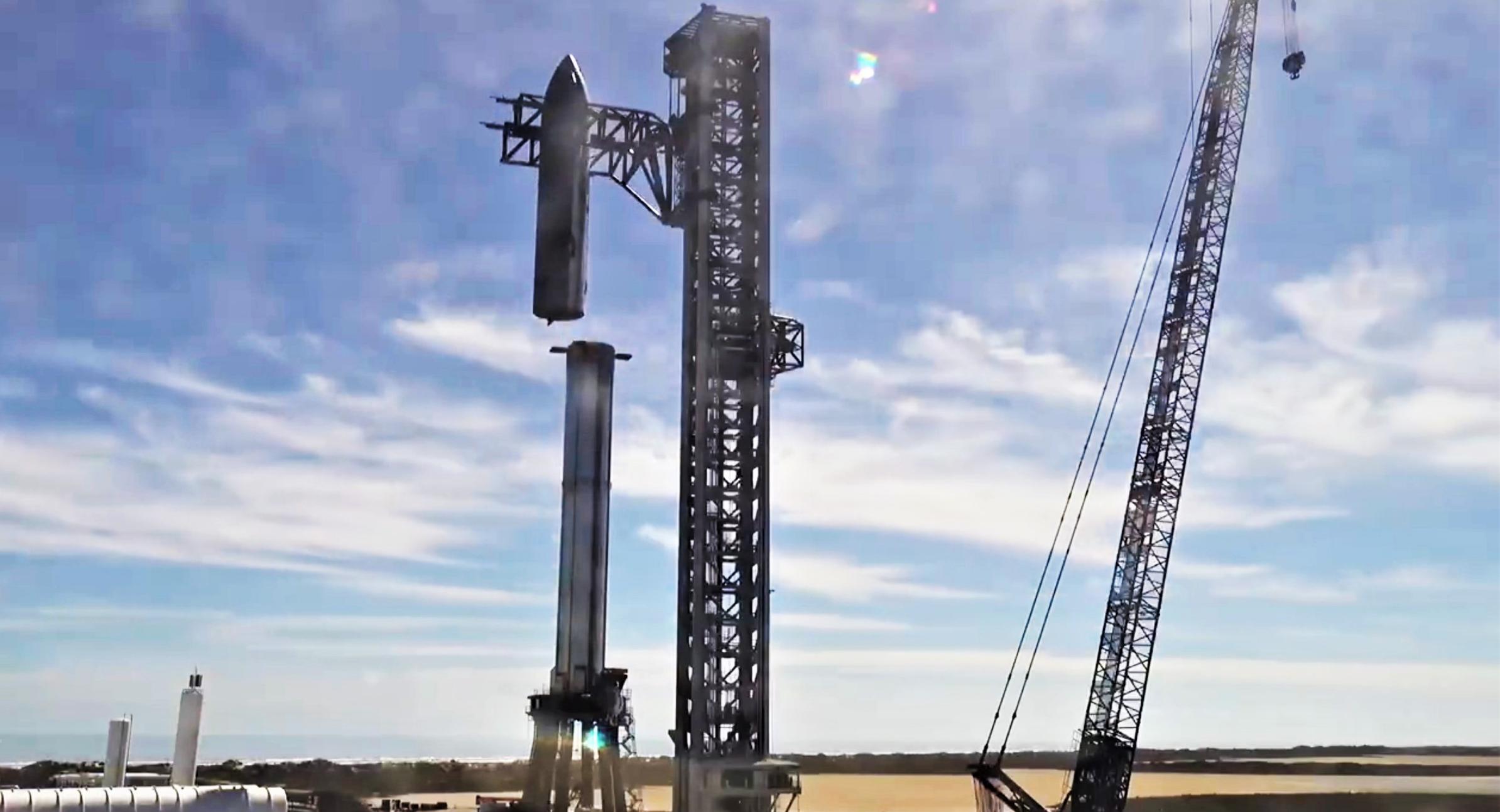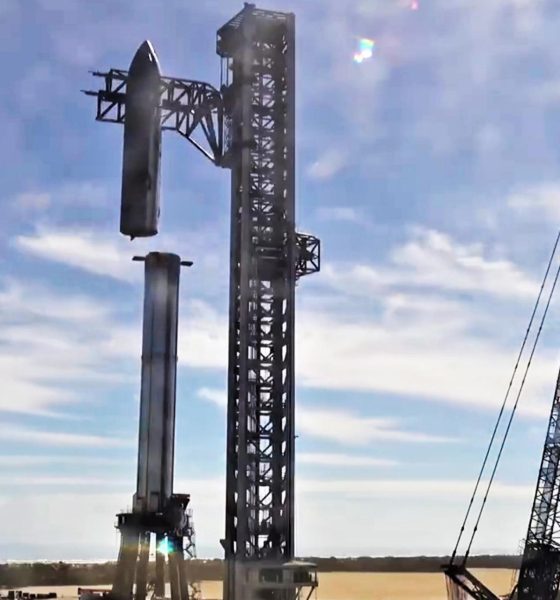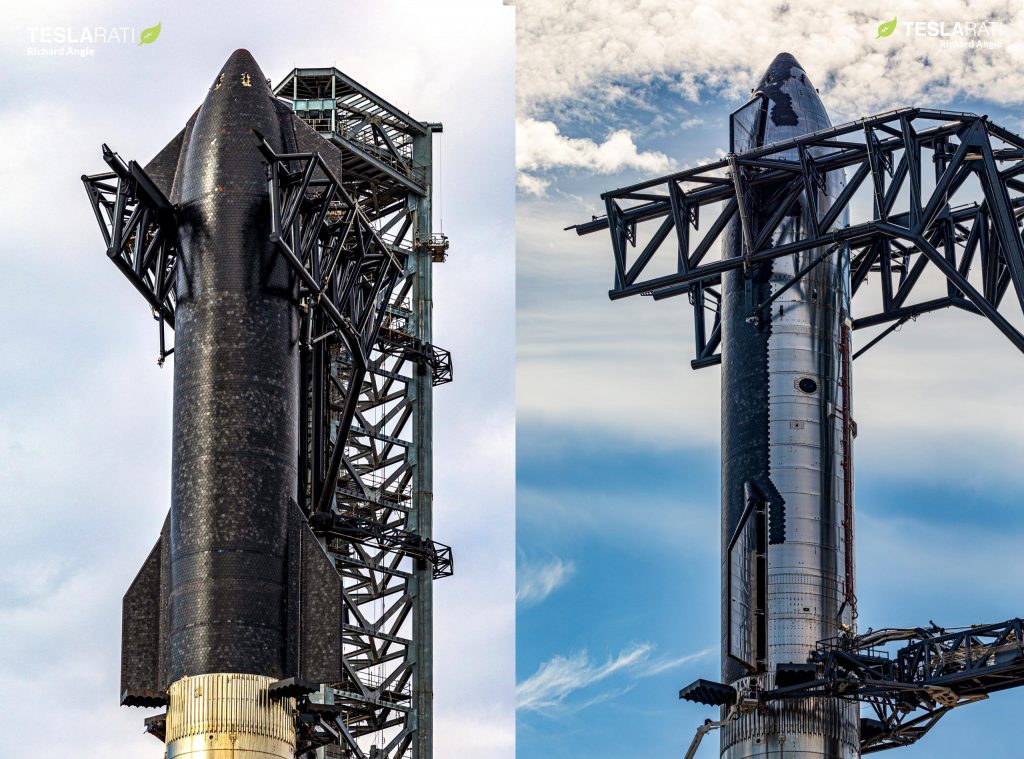

News
SpaceX ‘destacks’ Starship and Super Heavy: what’s next?
On February 14th, a bit less than four days after the giant rocket was used as a backdrop for CEO Elon Musk’s first Starship presentation in years, SpaceX lifted Starship off of the Super Heavy booster and lowered the upper stage to the ground.
In early August 2021, the same pair – Booster 4 and Ship 20 – were stacked for the first time for what was described as a fit test. After briefly forming the largest rocket ever assembled, the stages were ‘destacked’ about an hour later and would ultimately return to the Starbase factory for finishing touches. Six months, one ship cryoproof, three booster cryoproofs, and three ship static fire tests later, Ship 20 and Booster 4 were once stacked to form a massive 119-meter-tall (390 ft) tall rocket
This time around, Starship S20 was stacked on top of Super Heavy B4 not with a giant crane but with a ‘launch and integration tower’ that had been outfitted with three giant arms in the interim. The tower’s main pair of arms – ‘chopsticks’ – lifted the ~100-ton (~220,000 lb) Starship almost 100 meters off the ground, swung it over Super Heavy, and then carefully lowered the stages until Super Heavy was able to latch on.
On its first true demonstration, the complex process went far smoother than anyone outside of SpaceX expected, taking the tower just four or so hours from the start of the lift to hard mate. On February 10th, shortly before Musk’s Starship update, SpaceX even opened the ‘chopsticks’ to their full breadth, leaving all of Starship S20’s weight on Super Heavy B4 and also demonstrating what the pad will likely look like moments before the first orbital Starship launch.
On February 14th, after about four days fully stacked, the tower arms reattached to Ship 20, detached from Super Heavy, and lowered the Starship back to the ground, where it was eventually installed on a transport stand. Later that night and early the next day, SpaceX then moved the ship to a small concrete pad adjacent to the launch tower that’s believed to be meant for cryogenic proof testing. It’s unclear why SpaceX didn’t tested the fully stacked Starship given that both ship and booster have already completed multiple cryogenic proof tests (or wet dress rehearsals with real propellant) over the last few months.

It’s also unclear what more SpaceX can gain from testing Ship 20 on the ground, short of full-stack operations. On Sunday, February 13th, SpaceX did, however, begin filling the orbital launch site’s fuel tanks with liquid methane (LCH4) for the first time. It’s possible that instead of using Ship 20 to test any aspect of the relatively ancient Starship prototype, SpaceX will use Ship 20 to test the orbital tank farm – particularly the fuel side of the farm, which has yet to be tested. Perhaps after testing those systems on the ground, SpaceX will re-stack Ship 20 and Booster 4 and perform a similar wet dress rehearsal to test the tower’s plumbing, the ship-fueling arm, and the overall structural integrity of the fully-stacked rocket.
SpaceX has test windows tentatively scheduled on February 16th, 17th, and 18th.

News
Tesla FSD fleet is nearing 7 billion total miles, including 2.5 billion city miles
As can be seen on Tesla’s official FSD webpage, vehicles equipped with the system have now navigated over 6.99 billion miles.

Tesla’s Full Self-Driving (Supervised) fleet is closing in on almost 7 billion total miles driven, as per data posted by the company on its official FSD webpage.
These figures hint at the massive scale of data fueling Tesla’s rapid FSD improvements, which have been quite notable as of late.
FSD mileage milestones
As can be seen on Tesla’s official FSD webpage, vehicles equipped with the system have now navigated over 6.99 billion miles. Tesla owner and avid FSD tester Whole Mars Catalog also shared a screenshot indicating that from the nearly 7 billion miles traveled by the FSD fleet, more than 2.5 billion miles were driven inside cities.
City miles are particularly valuable for complex urban scenarios like unprotected turns, pedestrian interactions, and traffic lights. This is also the difference-maker for FSD, as only complex solutions, such as Waymo’s self-driving taxis, operate similarly on inner-city streets. And even then, incidents such as the San Francisco blackouts have proven challenging for sensor-rich vehicles like Waymos.
Tesla’s data edge
Tesla has a number of advantages in the autonomous vehicle sector, one of which is the size of its fleet and the number of vehicles training FSD on real-world roads. Tesla’s nearly 7 billion FSD miles then allow the company to roll out updates that make its vehicles behave like they are being driven by experienced drivers, even if they are operating on their own.
So notable are Tesla’s improvements to FSD that NVIDIA Director of Robotics Jim Fan, after experiencing FSD v14, noted that the system is the first AI that passes what he described as a “Physical Turing Test.”
“Despite knowing exactly how robot learning works, I still find it magical watching the steering wheel turn by itself. First it feels surreal, next it becomes routine. Then, like the smartphone, taking it away actively hurts. This is how humanity gets rewired and glued to god-like technologies,” Fan wrote in a post on X.
News
Tesla starts showing how FSD will change lives in Europe
Local officials tested the system on narrow country roads and were impressed by FSD’s smooth, human-like driving, with some calling the service a game-changer for everyday life in areas that are far from urban centers.

Tesla has launched Europe’s first public shuttle service using Full Self-Driving (Supervised) in the rural Eifelkreis Bitburg-Prüm region of Germany, demonstrating how the technology can restore independence and mobility for people who struggle with limited transport options.
Local officials tested the system on narrow country roads and were impressed by FSD’s smooth, human-like driving, with some calling the service a game-changer for everyday life in areas that are far from urban centers.
Officials see real impact on rural residents
Arzfeld Mayor Johannes Kuhl and District Administrator Andreas Kruppert personally tested the Tesla shuttle service. This allowed them to see just how well FSD navigated winding lanes and rural roads confidently. Kruppert said, “Autonomous driving sounds like science fiction to many, but we simply see here that it works totally well in rural regions too.” Kuhl, for his part, also noted that FSD “feels like a very experienced driver.”
The pilot complements the area’s “Citizen Bus” program, which provides on-demand rides for elderly residents who can no longer drive themselves. Tesla Europe shared a video of a demonstration of the service, highlighting how FSD gives people their freedom back, even in places where public transport is not as prevalent.
What the Ministry for Economic Affairs and Transport says
Rhineland-Palatinate’s Minister Daniela Schmitt supported the project, praising the collaboration that made this “first of its kind in Europe” possible. As per the ministry, the rural rollout for the service shows FSD’s potential beyond major cities, and it delivers tangible benefits like grocery runs, doctor visits, and social connections for isolated residents.
“Reliable and flexible mobility is especially vital in rural areas. With the launch of a shuttle service using self-driving vehicles (FSD supervised) by Tesla in the Eifelkreis Bitburg-Prüm, an innovative pilot project is now getting underway that complements local community bus services. It is the first project of its kind in Europe.
“The result is a real gain for rural mobility: greater accessibility, more flexibility and tangible benefits for everyday life. A strong signal for innovation, cooperation and future-oriented mobility beyond urban centers,” the ministry wrote in a LinkedIn post.
News
Tesla China quietly posts Robotaxi-related job listing
Tesla China is currently seeking a Low Voltage Electrical Engineer to work on circuit board design for the company’s autonomous vehicles.

Tesla has posted a new job listing in Shanghai explicitly tied to its Robotaxi program, fueling speculation that the company is preparing to launch its dedicated autonomous ride-hailing service in China.
As noted in the listing, Tesla China is currently seeking a Low Voltage Electrical Engineer to work on circuit board design for the company’s autonomous vehicles.
Robotaxi-specific role
The listing, which was shared on social media platform X by industry watcher @tslaming, suggested that Tesla China is looking to fill the role urgently. The job listing itself specifically mentions that the person hired for the role will be working on the Low Voltage Hardware team, which would design the circuit boards that would serve as the nervous system of the Robotaxi.
Key tasks for the role, as indicated in the job listing, include collaboration with PCB layout, firmware, mechanical, program management, and validation teams, among other responsibilities. The role is based in Shanghai.
China Robotaxi launch
China represents a massive potential market for robotaxis, with its dense urban centers and supportive policies in select cities. Tesla has limited permission to roll out FSD in the country, though despite this, its vehicles have been hailed as among the best in the market when it comes to autonomous features. So far, at least, it appears that China supports Tesla’s FSD and Robotaxi rollout.
This was hinted at in November, when Tesla brought the Cybercab to the 8th China International Import Expo (CIIE) in Shanghai, marking the first time that the autonomous two-seater was brought to the Asia-Pacific region. The vehicle, despite not having a release date in China, received a significant amount of interest among the event’s attendees.








